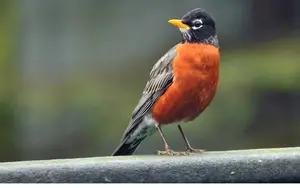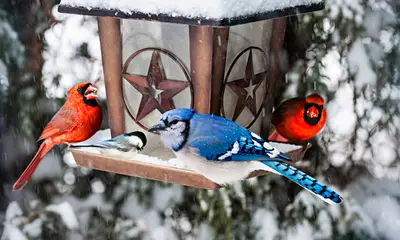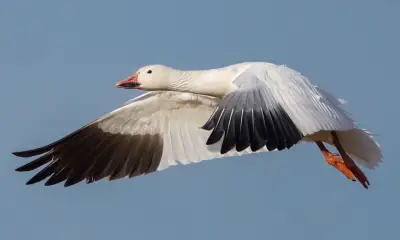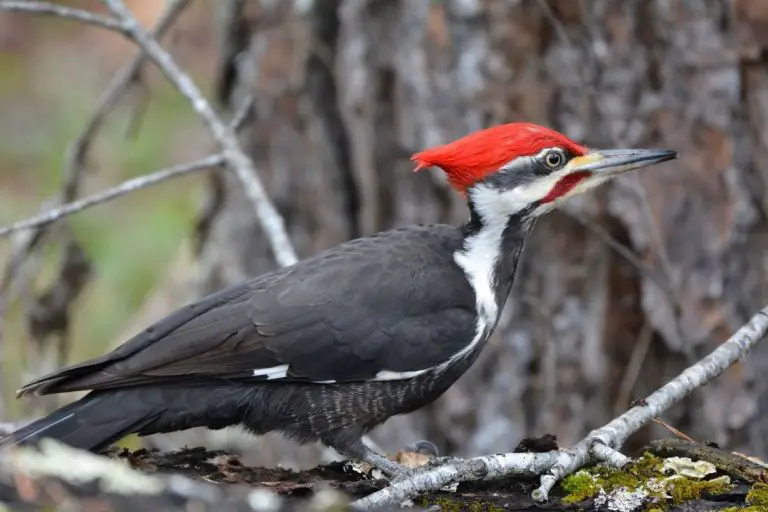15 Types Of GREEN BIRDS In Texas (ID Guide With Photos)
Did you recently come across a green-colored bird in Texas, and want to know what species it was?
Identifying green birds in the Lone Star State is not as easy as it might seem, since there are many bird species in Texas that are either entirely or partially green.
To help you identify the bird you saw, we’ll cover the most common green birds of Texas in this article.
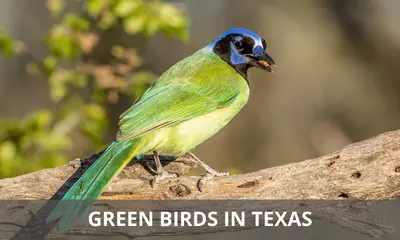
What are the types of green birds in Texas?
The 15 types of green-colored birds in Texas are:
- Monk Parakeet
- Rose-Ringed Parakeet
- Green Budgerigar
- Green Parakeet
- Red-crowned Parrot
- Green Jay
- Green Kingfisher
- Green Heron
- Buff-bellied Hummingbird
- Wilson’s Warbler
- Violet-green Swallow
- Lewis’s Woodpecker
- Mexican Violetear
- Green-breasted Mango
While some of these green birds are parrots (or parakeets), there are also several other Texas birds that are largely green.
The feral populations of parrots that live in Texas are descended from birds that were originally introduced by humans, but some of these are now regular breeding birds in Texas.
Now let’s dive into the details, and take a closer look at each of these species in order to get the full scoop:
Monk Parakeet
Scientific name: Myiopsitta monachus
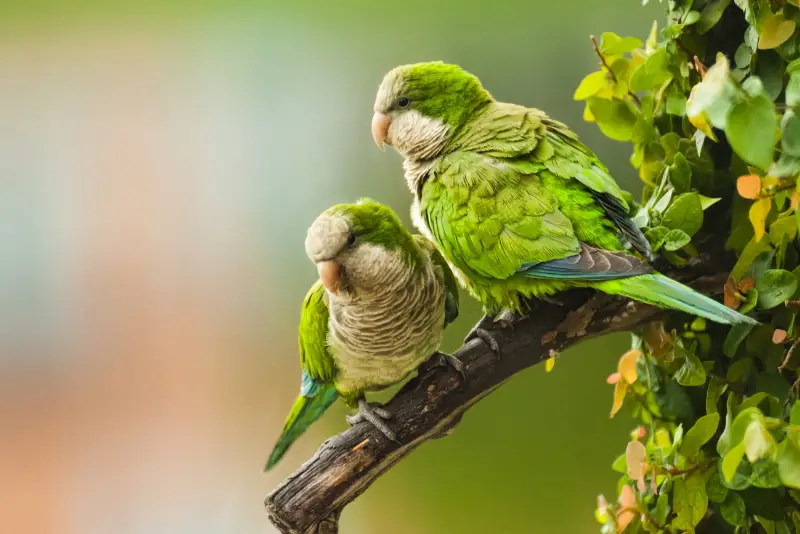
Monk Parakeets are the most common parrots in Texas, and are present in growing numbers in Houston, Dallas, Austin, and several other urban centers of Texas.
Monk Parakeets are also known as Quaker Parrots, and look like miniature macaws with long tails
They have lime green heads and backs, and white underparts. These parakeets are very social animals, living in large flocks that build bulky nests together.
These green birds feed on fruits, berries, buds, flowers, and seeds. During the breeding season, males will compete for mates by making high-pitched whistling sounds.
While these psittacids are regarded as an agricultural pest in their native range in Argentina and other South American countries, they are largely a welcome sight in Texas.
Rose-Ringed Parakeet
Scientific name: Psittacula krameri
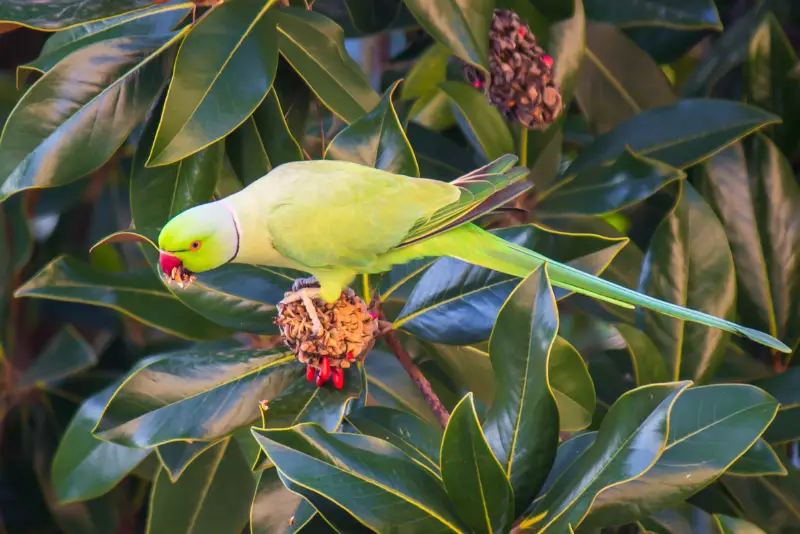
The Rose-ringed Parakeet can be found in small numbers in Texas. These birds are also known as Ring-necked Parakeets because of the distinctive ring on their necks.
These bright green parrots are found in south Texas, where they feed on fruits, seeds, nuts, insects, and worms and nest in tree cavities.
Originally from India and sub-saharan Africa, escaped birds of this species have successfully colonized many parts of the world, including Northern and Western Europe, the Arabian Gulf, Florida, and Texas.
Green Budgerigar
Scientific name: Melopsittacus undulatus
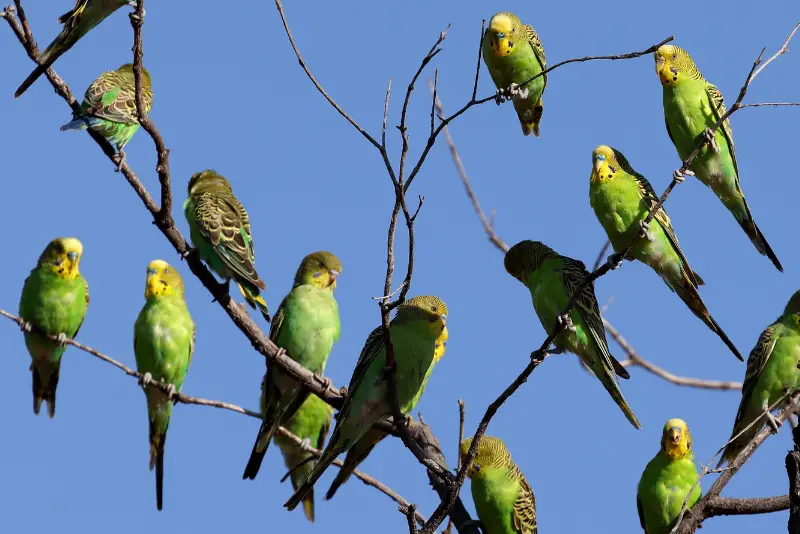
Did you know you can see wild budgies in Texas?
These birds are originally native to Australia and New Guinea, where they were named budgerigars only after non-natives had trouble pronouncing the original name, “gidjirrigaar”, which is a Gamilaraay word.
Although these birds have been given this distinctive (albeit erroneous) name, they also go by the more simple name Common Parakeet, or Shell Parakeet.
Since the 1960s, budgies have been reported breeding in several of Texas’s counties. Budgerigars can be either green, yellow, or light blue, combined with a gray striped back.
They eat insects, spiders, worms, and other invertebrates, and they also love to play with toys!
Green Parakeet
Scientific name: Psittacara holochlorus
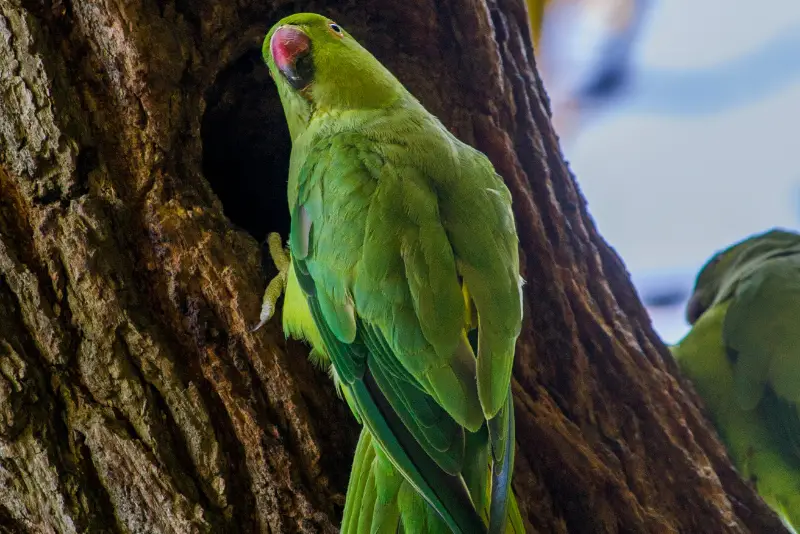
As its name suggests, this parakeet is entirely green, except for a thin black line along its neck, and a bright orange beak.
In Texas, these birds have a breeding population in the Rio Grande valley, although their population size is currently not certain.
This parakeet favors swamp forests and woodlands in the wild, but in suburban areas also occurs in royal palm groves.
Red-Crowned Parrot
Scientific name: Amazona viridigenalis
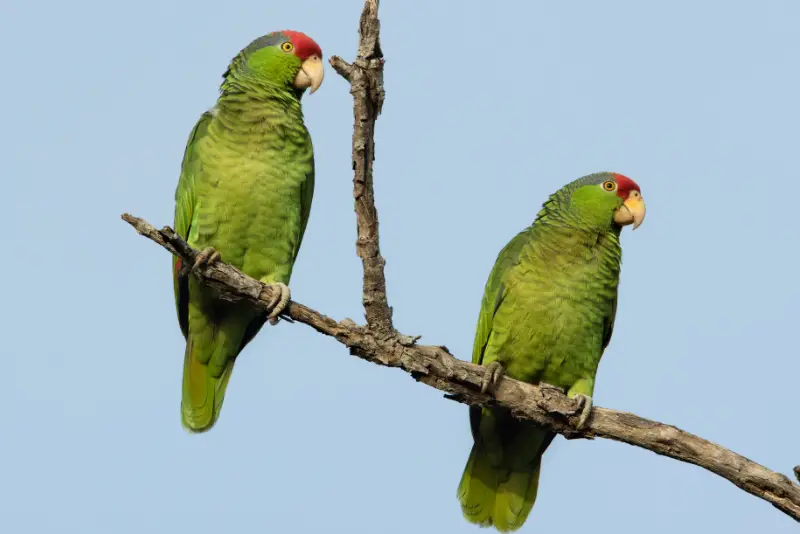
This green-colored bird is endemic to the rainforests of Southeast Asia; however, these parrots are also found in California, Texas, Hawaii, and Puerto Rico.
These birds are also known as Red-crowned Amazons, and they have a red crest on their head and a yellow belly. They also have a long, curved beak, and a yellow throat.
These birds are omnivores, eating fruit, seeds, leaves, nectar, and insects. They prefer to live in dense vegetation and often perch on branches while hunting for food.
Green Jay
Scientific name: Cyanocorax yncas

The Green Jay is unmistakable, due to its bright green body color combined with a blue head and black throat.
This Jay is most common in southern Texas in the lower Rio Grande Valley.
While it has a bright coloration, it can be hard to spot because it likes to stay hidden in thick scrub, and you need to make an effort to catch a glimpse of this beautiful green bird.
It frequents a variety of woodland and shrubland, and forages for insects, seeds, and fruits.
Green Kingfisher
Scientific name: Chloroceryle americana
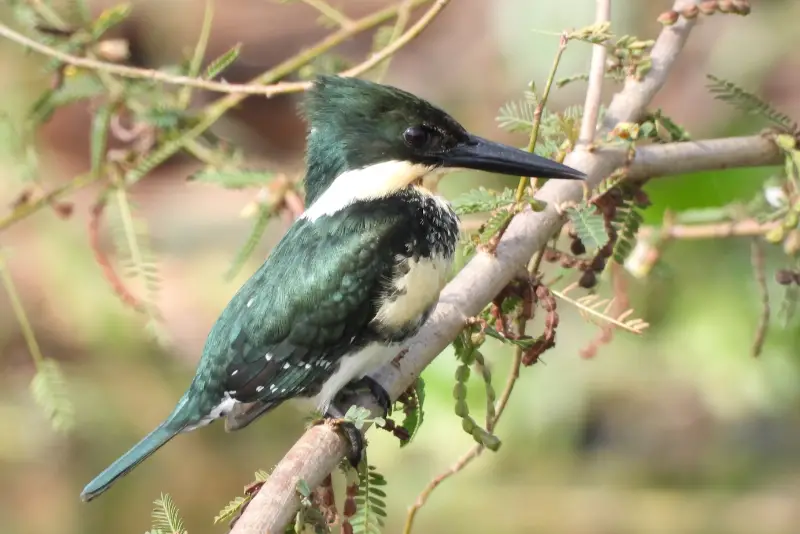
This Kingfisher is found throughout Texas, but almost nowhere else in the United States.
It is a small kingfisher species that is easily identifiable due to its emerald green upperparts, which contrast with its white collar and chestnut brown chest.
This bird is highly territorial, and breeding pairs stay in their territory all year round. It is found close to rivers and streams with plenty of vegetation on the banks.
Green Heron
Scientific name: Butorides virescens

The Green Heron is a medium-sized heron with an olive-green body and black wings.
Herons tend to live near water, so they’re often seen around lakes, rivers, ponds, or even swimming pools.
These green-colored birds eat fish, frogs, snails, small reptiles, amphibians, and crustaceans. They nest in trees or shrubs but sometimes build their nests on islands.
The green heron is usually silent except when it makes its characteristic call, which sounds like “kreee.” This bird can reach up to three feet tall, and males have long yellow bills.
Buff-bellied Hummingbird
Scientific name: Amazilia yucatanensis

Buff-bellied Hummingbirds are regular winter visitors in the Gulf Coast region of Texas, where they can be seen visiting flowers and nectar feeders in urban areas.
They breed along the Gulf Coast of Mexico, and unlike most other bird species, they actually move north during the winter.
Buff-bellied Hummingbirds have an emerald green body, chest, and throat, while their wings are dark brown and the tail is rufous orange.
These birds frequent acacia and mesquite woodlands and shrubland, and are able to feed on a wide variety of nectar sources, as well as small insects.
Wilson’s Warbler
Scientific name: Cardellina pusilla
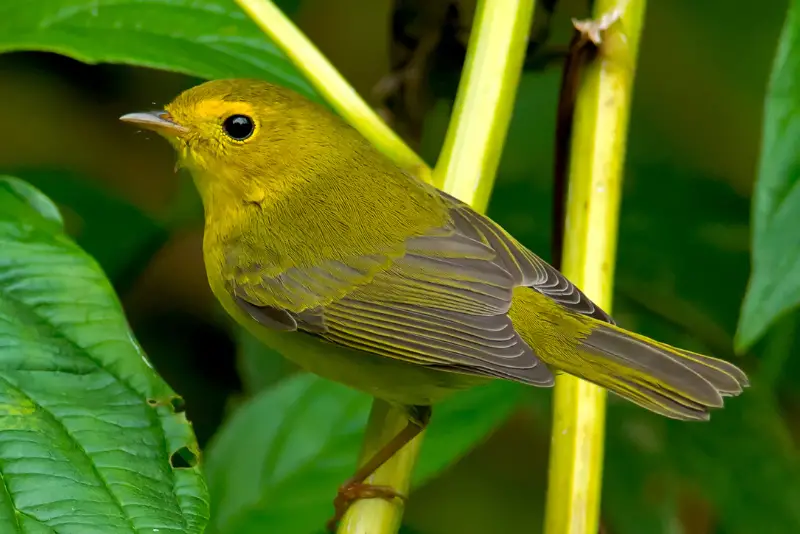
Wilson’s Warbler is a small green bird with olive upperparts and yellowish green underparts. Adult males also have a black crown.
This warbler occurs in Texas as a rare visitor during spring and fall migration, as it passes through Texas from its breeding grounds in Canada to its wintering grounds in Central America.
It frequents damp woodlands with dense shrubs, where it forages for small insects and other invertebrates.
Violet-green Swallow
Scientific name: Tachycineta thalassina
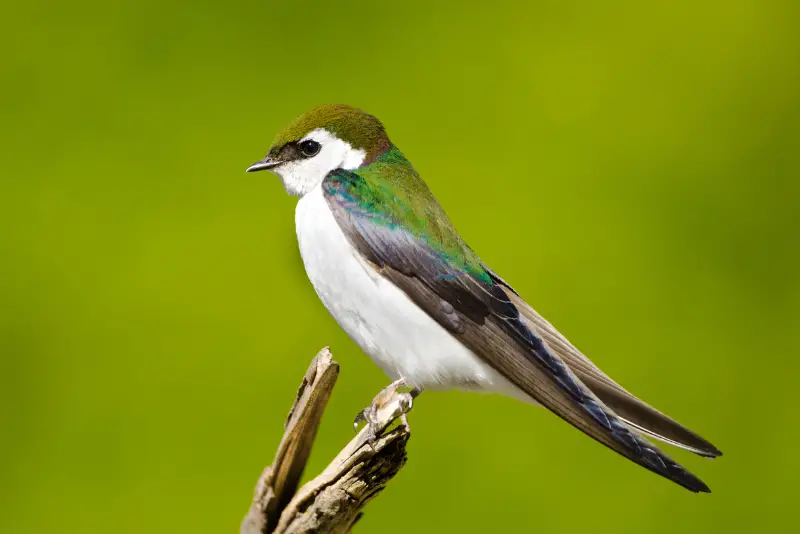
This beautiful swallow is a bird of the western USA, and is found as a summer visitor in western Texas.
While this swallow initially looks like it has an entirely dark upper side, when it catches the sunlight, you’ll notice the iridescent green plumage on its back.
These swallows readily accept nesting boxes, and other nest cavities in urban areas. They are most often observed hunting insects over rivers and lakes.
During the cold season they migrate south to spend the winter in Mexico and Central America.
Lewis’s Woodpecker
Scientific name: Melanerpes lewis

Lewis’s Woodpecker is a bird of the western USA, and is a rare breeding bird in west Texas.
The upperparts of this woodpecker are dark green, as is the head, while the underside is light red.
Another distinguishing feature of this large woodpecker is its broad gray collar that separates the dark head from the rest of the body plumage.
Mexican Violetear
Scientific name: Colibri thalassinus

The Mexican Violetear belongs to the hummingbird family, and is almost entirely metallic green, except for dark violet patches behind its eyes and cheeks.
This bird breeds in Mexico and Central America, and is found in Texas as a regular visitor outside of the breeding season.
Its preferred habitat is high-altitude rainforest, but in Texas it can be seen in gardens with flowers, and also visits hummingbird feeders.
Green-breasted Mango
Scientific name: Anthracothorax prevostii
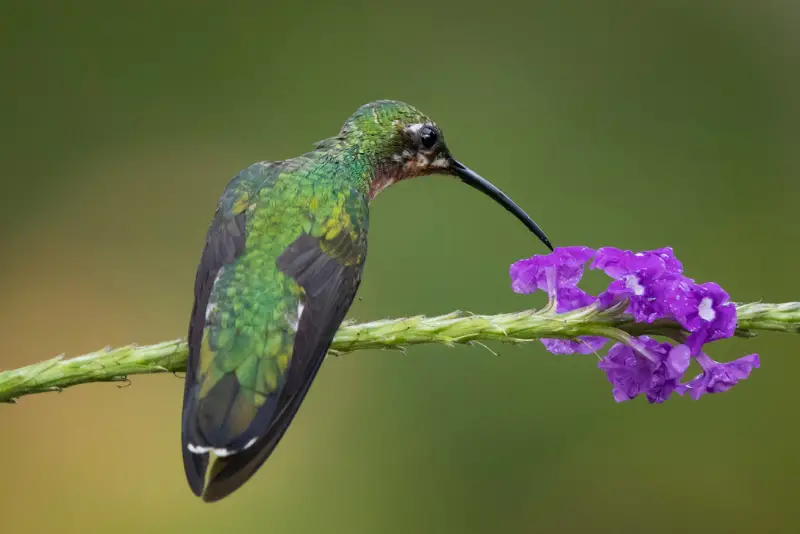
The Green-breasted Mango is another hummingbird species that breeds in Central America, but can be found as a regular non-breeding visitor in coastal Texas.
It is almost entirely glossy green, except for a black throat and purple tail. Most of the birds seen in Texas are young birds, which have grayish feather edges giving them a mottled appearance.
This large hummingbird normally feeds high in tree canopies, but it also sometimes visits nectar feeders.
Are there green parrots in Texas?
Yes, Texas is home to 11 species of parrots that are largely green.
The most common green parrot in Texas is the Monk Parakeet, which is steadily expanding its range and becoming a common sight in major Texas cities.
However, none of the parrots that breed in Texas are originally native to the Lone Star State.
Most of them are escaped birds from the pet trade, while others have been introduced by humans on purpose.
The success of these introduced birds is probably due to the mild climate in Texas, combined with access to a wide variety of exotic vegetation in urban habitats (including both tropical and subtropical plants).
Related: Guide to the parrots of Florida
Final Thoughts
Texas is home to some of the most impressive wildlife on the planet. The state has a wide range of habitats, from swamps and marshes to urban habitats and beaches along the Gulf Coast.
Texas is also home to many species of exotic birds that are not found anywhere else in North America, and green birds, in particular, seem to be found frequently throughout Texas.
Birds are amazing creatures. Although we may not always understand what they’re saying, we do know that they provide us with many benefits.
From pollinating plants to keeping pests away, birds play a very important role in our environment. And in Texas, you can find plenty of beautiful green birds in a range of different habitats.
If you enjoyed this article, check out our guide to the black birds in Texas.



